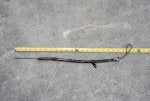Luckily (?), I changed my mind and decided to keep the car because some problems just happened this morning !
I started the car and despite the fact that it started pretty well after almost one month without starting it, I noticed quickly that not all cylinders were up and running, and after checking, N1 & 2 were not working, despite ignition occuring (sparks when closing the wire next to the plugs).
Then, I found out that a lot of fuel was coming out the small pipe under the
carburettors.
I suspect that something is wrong with the carbs, but before removing them and checking everything, since there are quite a pain to remove, (I hate crawling under the car to remove those bloody screws up there... ), I was wondering if anybody has had the same experience, or if there was any specific advices ?
), I was wondering if anybody has had the same experience, or if there was any specific advices ?
Lionel
I started the car and despite the fact that it started pretty well after almost one month without starting it, I noticed quickly that not all cylinders were up and running, and after checking, N1 & 2 were not working, despite ignition occuring (sparks when closing the wire next to the plugs).
Then, I found out that a lot of fuel was coming out the small pipe under the
carburettors.
I suspect that something is wrong with the carbs, but before removing them and checking everything, since there are quite a pain to remove, (I hate crawling under the car to remove those bloody screws up there...
Lionel







